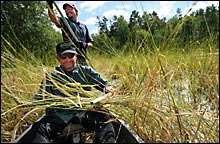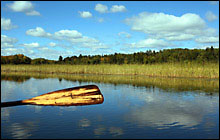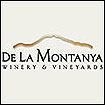|
RICE
GONDOLIER: Derek Starry (standing) poles his
canoe through a wild rice stand in Minnesota's
Upper Whitefish Lake. His uncle, Dave Starry,
bends the stalks over and uses a "flail"
to shake the rice loose.
photo: melanie s. freeman |
Backstory:
Harvesting the caviar of grain Across the lakes
of
Minnesota, the soft swish of wild rice against
harvest boats is
the sound of an ancient but fading tradition.
By Amanda Paulson | Staff writer of The Christian
Science Monitor
PINE RIVER, MINN. - The wild rice harvest
in Minnesota is ending, and Dave Starry is generally
pleased. He and his nephew, Derek Starry, managed
to shake loose about 4,000 pounds of rice into
their flat-bottomed boat over the course of 20
days.
Still, they can't stop thinking about the rice
that got away. It was a dry summer, and lake levels
were low - meaning rice had lots of shallow water
to flourish, but the ricers couldn't navigate
the shallows to reach it.
"You could see it standing there and wanted
it so bad you could taste it," says Dave,
a third-generation logger who grew up ricing.
"It was a bumper crop, but a lot we couldn't
get to."
Not unlike natives of this region 2,500 years
ago, Derek poles their canoelike boat through
shallow water as Dave bends stalks over and beats
them with two wooden rods called "flails"
or "knockers" to shake the rice loose.
Ricers like the Starrys are a rarity these days.
In the 1960s, when prices were high, it wasn't
unusual for 15,000 people to buy permits from
the state's Department of Natural Resources. This
year, the DNR sold about 1,000.
It's exhausting, sweaty work, for little reward
- about $1 a pound, the same price it fetched
40 years ago, before the rise of cultivated wild
"paddy" rice pushed prices down. But
wild rice is valuable to more than the harvesters,
and it's been getting increasing focus lately
from environmental groups in the state.
"There's a lot of pressure on wild rice habitat,"
says Rod Ustipak, who coordinates a rice management
program run by the DNR and Ducks Unlimited. Vacationers,
he says, want deep clear lakes, not realizing
they're an ecological wasteland. They're also
impossible for rice grass to grow in.
Mr. Ustipak - a ricer himself - spends much of
his time monitoring shallow lakes that seem to
be filling in, often from beaver dams or plugged-up
culverts, which he or his management team unplug.
At the same time, he works through the courts
to get certain lakes protected as "game lakes,"
or to reset legal elevation water levels.
Wild rice, a different genus than traditional
rice, is the basis of the food chain in Minnesota's
lakes. Many waterfowl eat the kernels, which also
decompose and feed invertebrates upon which other
birds depend.
"If we didn't have the management program
in place, that whole thing would be open water,"
says Ustipak, pointing out at a lake he monitors,
teeming with coots, wood ducks, trumpeter swans,
sora rails, and mergansers - and, of course, massive
stands of wild rice. "There wouldn't be anything
out there except a few odd ducks."
But while he mainly wants to conserve the wild
rice habitat for such species, Ustipak hopes to
encourage interest among human ricers as well.
Ricing is the cultural center of many Ojibwe tribes
in the state, and Ustipak sees it as a key to
helping to convey the value of the ecosystems.
|
| LAKE
HARVEST: Across an oar is a lush stand of
wild rice - abundant in a drought year because
rice thrives in shallow water |
"You think of these people harvesting rice
here 2,500 years ago - it was their lifeblood,"
he says as he paddles a canoe through Whitefish
Lake. "We've gotten so far from the land."
He guesses that only a couple hundred thousand
pounds of rice will be harvested this year, far
from the 3 million pounds often harvested in the
'60s and '70s. And native communities worry that
the ricing traditions are dying out among young
people.
Still, Ustipak is gratified to see so much habitat
returning - last year, 8,500 acres of Big Rice
Lake were restored to productive habitat - and
says that he appreciates the days he can get out
and do his own ricing more each year.
"There's nothing else quite like it - the
soft swish of rice on the boat, out there with
your ricing partner," he says. "Now
since there's so few of us, we value each other
more.
"Backstory:
Harvesting the caviar of grain
















